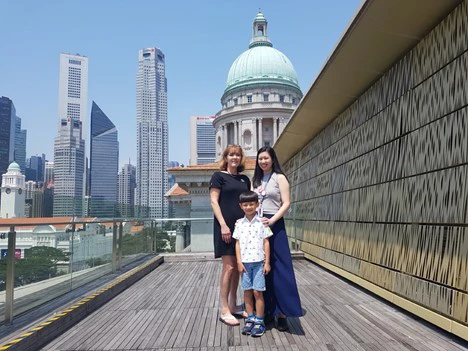Volunteer Voices: Connecting As We Volunteer
In this run of Volunteer Voices, Sim Jia Ning (Intern, Community & Access) caught up with Gallery volunteers Esther Tan, Chua Wan Yi and Fayanne Tan to find out how they bonded during their training to become bilingual docents.

Connecting as We Volunteer: A Journey of Art and Friendship
Best Friends of the Gallery (BFG) is National Gallery Singapore’s flagship volunteering programme. It brings like-minded individuals, friends and families who are passionate about art, community and people together.
In this article, Sim Jia Ning, ex-intern with the Community & Access team, speaks to Gallery volunteers Esther Tan, Chua Wan Yi and Fayanne Tan to find more about the journey they have been since joining the BFG programme. Despite their full-time jobs, the trio have carved out time to volunteer as docents at the Gallery since 2017. Esther is a business executive at a pharmaceutical company, Wanyi works in the marketing department of a shopping mall and Fayanne is part of the student development team at Temasek Polytechnic. Strangers before, they bonded during their training to be bilingual docents.
1. How It Began
Wan Yi: My journey with the Gallery began when I attended a DBS Singapore Gallery tour back in 2015, when the museum first opened. Out of the many artworks I saw, Chua Mia Tee’s National Language Class left the deepest impression on me. I was blown away by how the docent conveyed the stories behind this monumental artwork. Interested in guiding, I asked the docent for more information on the Gallery’s docent programme and signed up straightaway.
Esther: I am actually not new to docent programmes. Before joining the Gallery, I was guiding at Singapore Art Museum until it closed for renovation. That was how I ended up joining the docent training programme at the Gallery, where I met Wan Yi and Fayanne.
Fayanne: After visiting many museums in Europe, I realised that I know very little about local art history and museums. By chance, I came across the Gallery’s docent recruitment and thought it was an opportunity to grow my art knowledge. That’s how I started my BFG journey!

2. Learning and Bonding Together
Wan Yi: When I signed up with the docent programme, there were a lot more English-speaking docents than Mandarin-speaking ones. Since I was confident in my Mandarin skills, I decided to take up bilingual guiding. The training process was rigorous, and we had to memorise many names and artworks titles in Chinese. Fortunately, I was in the same mentorship group as Esther and Fayanne. We bonded by learning and sharing research with one another! Having them along the way made the process so much more fun!
Esther: I remember the three of us hanging out at the Gallery café after our training sessions too! With our shared interest in the arts, we also attended exhibitions together. As for why I became a bilingual docent, my reason is similar to Wan Yi’s. Back then, I frequently travelled to China for work, and the programme was a good chance to improve my Mandarin .
Fayanne: I actually had no intention of becoming a bilingual docent. During my interview, I was persuaded by Gallery staff to try out guiding in Mandarin guiding because they were impressed with my Chinese results in school! I also demonstrated good proficiency in the language. To help everyone during the training, I initiated weekly sharing sessions so that we could update each other on our latest research. We had these sessions at our Volunteer Room in the Gallery.

3. Discovering a New Way to Travel
Esther: Back in 2018, the Gallery held a beautiful exhibition titled Colours of Impressionism: Masterpieces from the Musée d'Orsay. Inspired by the artworks, we decided to travel to Europe to trace the lives of the Impressionist masters in their hometowns. We visited places like the Claude Monet Foundation in Giverny, Atelier de Cezanne (Paul Cezanne’s studio) in Aix-en-Provence, as well as Saint-Remy-de-Provence, where Vincent van Gogh was hospitalised.
Fayanne: Even though we had all travelled to Europe before, we decided to make this trip more art-centric so that we could explore the Impressionism movement in depth. All of us suggested places to visit and the trip ended up being mostly art museums, artist hometowns and studios.
Wan Yi: It was a refreshing travel experience for me as when I travel with family, we usually never focus on the arts. Thanks to Esther and Fayanne, I have friends who are interested in “artsy” activities!

4. Making (unexpected) Connections
Wan Yi: I feel that an art tour should be about the dialogue between the guide and visitors, rather than a one-way transfer of information. I have had so many unexpected guiding encounters. On one of my tours, I met a super enthusiastic Russian lady who knew more about art than me! Amazingly, we are still in contact. She was supposed to visit Singapore but had to cancel her plans due to the pandemic.
Esther: I like engaging with people from all walks of life, and from different cultures and different countries. Volunteering offers great chances to meet people from all over the world and the thing that connects all of us is a love for the arts. I had the opportunity to guide a group of foreign domestic workers on a trip organized by Aidha, and it was an enriching experience for me. I believe that volunteering is also impactful as I can help make someone’s day.
Fayanne: Sometimes visitors, especially tourists, share new knowledge. I see these as valuable learning experiences. On one of my tours, I met an Australian architect who shared the names of famous architects behind some of the nearby buildings in the Civic District, all of whom I did not know! I love relating to the incredibly diverse range of visitor stories, and I see myself as an advocate of the Gallery who establishes a connection between the institution and the community.













